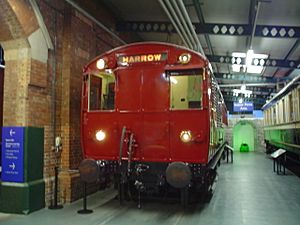LNWR electric units facts for kids
Quick facts for kids LNWR electric units |
|
|---|---|

LNWR EMU Motor Car at National Railway Museum, York
|
|
| In service | 1927-1960 |
| Manufacturer | Metropolitan-Cammell |
| Formation | power car + trailer + driving trailer |
| Operator(s) | LMS and British Railways |
| Specifications | |
| Power output | 4 x 280 hp traction motors total 1,120 hp (836 kW) |
| Electric system(s) | 630 V DC third and fourth rail |
| Track gauge | standard gauge |
The LNWR electric units were special electric trains used by the London and North Western Railway (LNWR) in the early 1900s. These trains helped to modernize travel around London. They were part of a big plan to make train journeys faster and cleaner by using electricity instead of steam.

Contents
Electric Trains for London
Between 1909 and 1922, the London and North Western Railway started a huge project. They wanted to electrify all their train lines around London. This meant changing them from steam trains to electric trains.
Which Lines Were Electrified?
The project included important lines from London Euston to Watford. It also covered the North London Railway from London Broad Street to Richmond. Smaller lines were also included, like the one from Watford to Croxley Green. A special building called a depot was built at Croxley Green to keep these new electric trains. The new electric lines also connected to what would later become the London Underground system.
How the Trains Got Power
These train lines used a special way to get electricity. It was called the fourth rail 630V DC system. This system used two extra rails on the tracks to carry the electricity. The power for these trains came from the LNWR's own power station. This power station was located in a place called Stonebridge Park.
When Services Started
The very first electric passenger trains began running in 1914. At first, they only ran on a short route. This route was the West London line, from Willesden to Earls Court. The plan was to have electric trains running everywhere much sooner. However, the First World War caused many delays. Because of this, the full electric train service across the whole network did not start until 1922.
Later Extensions
Years later, in 1927, another railway company took over. This was the London, Midland and Scottish Railway. They continued to expand the electric network. They added more electric lines, including a branch line to Rickmansworth. These electric units served passengers for many years. They were finally taken out of service in 1960.

